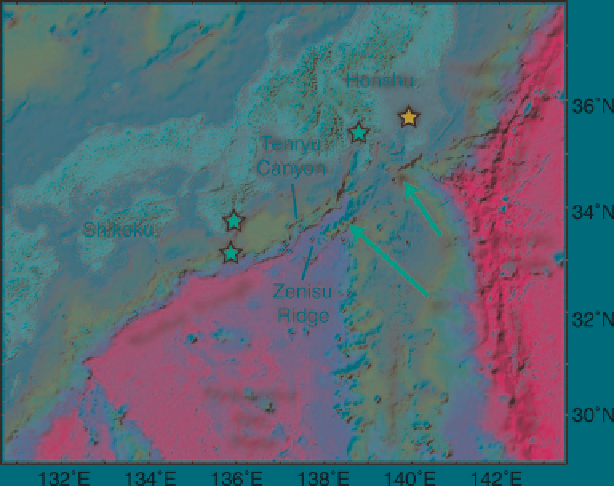Geoscience Reference
In-Depth Information
region to the west. The preferred hypothesis links the transpressional deformation
to a subducted seamount or paleo-Zenisu ridge, though it is alternatively possible
that transpression accommodates the northward collision of the Izu-Bonin arc and
Sagami trough, and oblique subduction of the Philippine Sea plate. The identifica-
tion of trench-perpendicular fold hinges in Plio-Pleistocene strata illustrates a large
component of previously unidentified elastic strain, and faulting that cuts this folded
strata may have a strike-slip component. Therefore, these submersible observations
are relevant to evaluating seismic hazards confronted by the Tokai region in Japan.
Keywords
Accretionary prism
•
Nankai
•
Thrust fault
•
Structural geology
•
Submersible geology
1
Introduction
The Nankai trough of Japan's (Honshu and Shikoku) southeastern margin is a type
locality for studying subduction-zone processes. Here, sediment from the Shikoku basin
has been scraped off the subducting Philippine Sea plate into an accretionary prism
adjacent to the colliding Izu-Bonin arc since late Miocene-early Pliocene time (Moore
and Karig
1976
; Seno
1977
; Le Pichon et al.
1987a, b
; Seno et al.
1996
) (Fig.
1
). Faults
Fig. 1
Plate-tectonic setting of Tenryu Canyon relative to the Nankai trough, Kii Peninsula, and
Tokyo Bay (
red star
). Plate convergence vectors compiled by Hirono (
2003
) (in mm/yr) illustrate
local variations in plate convergence in the Tenryu Canyon region; Pacific-Okhotsk plate conver-
gence rate is 70 mm/yr for reference Seno et al. (
1996
). Zenisu Ridge is one of several basement
ridges associated with the Izu-Bonin Arc that collide with the Tenryu canyon section of the Nankai
trough. Yellow stars mark the 1944 and 1946 Kii Peninsula epicentral regions and the 1856 Tokai
epicentral region (Base image produced with
Geomapapp
)

Search WWH ::

Custom Search